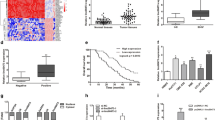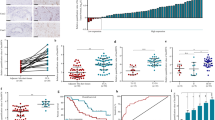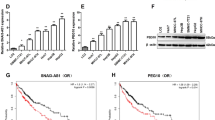Abstract
Background
Long noncoding RNA (lncRNA) small nucleolar RNA host gene 3 (SNHG3) is an oncogenic lncRNA that has been reported in many cancers, but the role of SNHG3 in cholangiocarcinoma (CCA) remains largely unknown. Bioinformatic analysis revealed a regulatory relationship among SNHG3, miR-3173–5p, and ERG. miR-3173–5p is a tumour suppressive miRNA, while ERG is an oncogene. In the present study, we focused on the regulatory effects and molecular mechanisms of SNHG3 in CCA.
Method
The expression of SNHG3 and miR-3173–5p was evaluated using qRT–PCR analysis. Knockdown of SNHG3 was achieved by shRNA. Cell viability was assessed by MTT assay. Migration and invasion were determined by Transwell assay. Flow cytometry was used to assess cell apoptosis. Western blots were applied to quantify protein levels. Furthermore, using RNA pulldown and dual luciferase assays, the interactions between SNHG3 and miR-3173–5p and between miR-3173–5p and ERG in CCA cells were validated.
Results
SNHG3 was significantly upregulated in CCA cells compared with normal human intrahepatic biliary epithelial cells. Knockdown of SNHG3 inhibited the proliferation and migration of CCA cells. Mechanistically, SNHG3-sponged miR-3173–5p, thus releasing the repression of ERG by miR-3173–5p. Rescue experiments showed that the miR-3173–5p/ERG axis mediated the oncogenic effect of SNHG3.
Conclusion
Taken together, our data suggest that SNHG3 is a pleiotropic oncogenic lncRNA in CCA. Knockdown of SNHG3 expression suppressed malignant phenotypes in CCA cells via the miR-3173–5p/ERG axis.





Similar content being viewed by others
Availability of Data and Material
All data generated or analysed during this study are included in this article. The datasets used and/or analysed during the current study are available from the corresponding author on reasonable request.
Abbreviations
- CCA:
-
Cholangiocarcinoma
- lncRNA:
-
Long non-coding RNAs
- SNHG3:
-
Small nucleolar RNA host gene 3
- miRNAs:
-
MicroRNAs
- ERG:
-
ETS-related gene
- qRT-PCR:
-
Quantitative real-time polymerase chain reaction
- RIP assay:
-
RNA immunoprecipitation
- 3′ UTR:
-
3′ Untranslated region
References
1.Salati M, Braconi C. Noncoding RNA in Cholangiocarcinoma. Seminars in liver disease. 2019;39(1):13-25. https://doi.org/10.1055/s-0038-1676097.
2.Razumilava N, Gores GJ. Cholangiocarcinoma. Lancet. 2014;383(9935):2168-79. https://doi.org/10.1016/S0140-6736(13)61903-0.
3.Fang Y, Fullwood MJ. Roles, Functions, and Mechanisms of Long Non-coding RNAs in Cancer. Genomics Proteomics Bioinformatics. 2016;14(1):42-54. https://doi.org/10.1016/j.gpb.2015.09.006.
4.Ponting CP, Oliver PL, Reik W. Evolution and functions of long noncoding RNAs. Cell. 2009;136(4):629-41. doi:https://doi.org/10.1016/j.cell.2009.02.006.
5.Huang W, Tian Y, Dong S, Cha Y, Li J, Guo X et al. The long non-coding RNA SNHG3 functions as a competing endogenous RNA to promote malignant development of colorectal cancer. Oncology reports. 2017;38(3):1402-10. https://doi.org/10.3892/or.2017.5837.
6.Xuan Y, Wang Y. Long non-coding RNA SNHG3 promotes progression of gastric cancer by regulating neighboring MED18 gene methylation. Cell death & disease. 2019;10(10):694. https://doi.org/10.1038/s41419-019-1940-3.
7.Zhang T, Cao C, Wu D, Liu L. SNHG3 correlates with malignant status and poor prognosis in hepatocellular carcinoma. Tumour biology : the journal of the International Society for Oncodevelopmental Biology and Medicine. 2016;37(2):2379-85. https://doi.org/10.1007/s13277-015-4052-4.
8.Tian D, Wei X, Zhu H, Zhu L, Li T, Li W. LncRNA-SNHG3 is an independent prognostic biomarker of intrahepatic cholangiocarcinoma. International journal of clinical and experimental pathology. 2019;12(7):2706-12.
9.Barbier J, Chen X, Sanchez G, Cai M, Helsmoortel M, Higuchi T et al. An NF90/NF110-mediated feedback amplification loop regulates dicer expression and controls ovarian carcinoma progression. Cell research. 2018;28(5):556-71. https://doi.org/10.1038/s41422-018-0016-8.
10.Tian L, Cao J, Ji Q, Zhang C, Qian T, Song X et al. The downregulation of miR-3173 in B-cell acute lymphoblastic leukaemia promotes cell invasion via PTK2. Biochemical and biophysical research communications. 2017;494(3-4):569-74. https://doi.org/10.1016/j.bbrc.2017.10.013.
11.Nicholas TR, Strittmatter BG, Hollenhorst PC. Oncogenic ETS Factors in Prostate Cancer. Adv Exp Med Biol. 2019;1210:409-36. https://doi.org/10.1007/978-3-030-32656-2_18.
12.Zhang Z, Chen F, Li S, Guo H, ** H, Deng J et al. ERG the modulates Warburg effect and tumor progression in cervical cancer. Biochem Biophys Res Commun. 2020;522(1):191-7. https://doi.org/10.1016/j.bbrc.2019.11.079.
13.Mochmann LH, Neumann M, von der Heide EK, Nowak V, Kuhl AA, Ortiz-Tanchez J et al. ERG induces a mesenchymal-like state associated with chemoresistance in leukemia cells. Oncotarget. 2014;5(2):351-62. https://doi.org/10.18632/oncotarget.1449.
14.Livak KJ, Schmittgen TD. Analysis of relative gene expression data using real-time quantitative PCR and the 2(-Delta Delta C(T)) Method. Methods. 2001;25(4):402-8. https://doi.org/10.1006/meth.2001.1262.
15.Wang WT, Ye H, Wei PP, Han BW, He B, Chen ZH et al. LncRNAs H19 and HULC, activated by oxidative stress, promote cell migration and invasion in cholangiocarcinoma through a ceRNA manner. Journal of hematology & oncology. 2016;9(1):117. https://doi.org/10.1186/s13045-016-0348-0.
16.Guo L, Zhou Y, Chen Y, Sun H, Wang Y, Qu Y. LncRNA ASAP1-IT1 positively modulates the development of cholangiocarcinoma via hedgehog signaling pathway. Biomedicine & pharmacotherapy = Biomedecine & pharmacotherapie. 2018;103:167-73. https://doi.org/10.1016/j.biopha.2018.04.015.
17.Dacheng W, Songhe L, Weidong J, Shutao Z, **g**g L, Jiaming Z. LncRNA SNHG3 promotes the growth and metastasis of colorectal cancer by regulating miR-539/RUNX2 axis. Biomedicine & pharmacotherapy = Biomedecine & pharmacotherapie. 2020;125:110039. https://doi.org/10.1016/j.biopha.2020.110039.
18.Zhang PF, Wang F, Wu J, Wu Y, Huang W, Liu D et al. LncRNA SNHG3 induces EMT and sorafenib resistance by modulating the miR-128/CD151 pathway in hepatocellular carcinoma. Journal of cellular physiology. 2019;234(3):2788-94. https://doi.org/10.1002/jcp.27095.
19.Zheng S, Jiang F, Ge D, Tang J, Chen H, Yang J et al. LncRNA SNHG3/miRNA-151a-3p/RAB22A axis regulates invasion and migration of osteosarcoma. Biomed Pharmacother. 2019;112:108695. https://doi.org/10.1016/j.biopha.2019.108695.
20.Shi J, Li J, Yang S, Hu X, Chen J, Feng J et al. LncRNA SNHG3 is activated by E2F1 and promotes proliferation and migration of non-small-cell lung cancer cells through activating TGF-beta pathway and IL-6/JAK2/STAT3 pathway. J Cell Physiol. 2020;235(3):2891-900. https://doi.org/10.1002/jcp.29194.
21.Adamo P, Ladomery MR. The oncogene ERG: a key factor in prostate cancer. Oncogene. 2016;35(4):403-14. https://doi.org/10.1038/onc.2015.109.
22.Li D, Chen Y, Mei H, Jiao W, Song H, Ye L et al. Ets-1 promoter-associated noncoding RNA regulates the NONO/ERG/Ets-1 axis to drive gastric cancer progression. Oncogene. 2018;37(35):4871-86. https://doi.org/10.1038/s41388-018-0302-4.
23.Li S, Wu X, Xu Y, Wu S, Li Z, Chen R et al. miR-145 suppresses colorectal cancer cell migration and invasion by targeting an ETS-related gene. Oncology reports. 2016;36(4):1917-26. https://doi.org/10.3892/or.2016.5042.
24.Wei Y, Peng J, He S, Huang H, Lin L, Zhu Q et al. miR-223-5p targeting ERG inhibits prostate cancer cell proliferation and migration. J Cancer. 2020;11(15):4453-63. https://doi.org/10.7150/jca.44441.
25.Zhao W, Qin P, Zhang D, Cui X, Gao J, Yu Z et al. Long non-coding RNA PVT1 encapsulated in bone marrow mesenchymal stem cell-derived exosomes promotes osteosarcoma growth and metastasis by stabilizing ERG and sponging miR-183-5p. Aging (Albany NY). 2019;11(21):9581-96. https://doi.org/10.18632/aging.102406.
Acknowledgements
We would like to give our sincere gratitude to the reviewers for their constructive comments.
Funding
This work was supported by Natural Science Foundation of Hunan Province (2021JJ70095) and **ang Wei Medical Administration medical office memorandum (2019) No.118 and research fund of Hunan Provincial Department of Education (20C1163).
Author information
Authors and Affiliations
Contributions
Conception and study design: Zeng-Peng Sun.
Data acquisition: Zeng-Peng Sun and Zhi-Guo Tan.
Data analysis: Chuang Peng and Wei-Min Yi.
Manuscript drafting: Wei-Min Yi.
Manuscript revising: Chuang Peng.
Corresponding author
Ethics declarations
Ethical Approval
Not applicable. This article does not contain any studies with human participants or animals performed by any of the authors.
Consent for Publication
Not applicable. This article does not contain any studies with human participants performed by any of the authors.
Conflict of Interest
The authors declare no competing interests.
Additional information
Publisher's Note
Springer Nature remains neutral with regard to jurisdictional claims in published maps and institutional affiliations.
Rights and permissions
About this article
Cite this article
Sun, ZP., Tan, ZG., Peng, C. et al. LncRNA SNHG3 Facilitates the Malignant Phenotype of Cholangiocarcinoma Cells via the miR-3173–5p/ERG Axis. J Gastrointest Surg 26, 802–812 (2022). https://doi.org/10.1007/s11605-021-05160-5
Received:
Accepted:
Published:
Issue Date:
DOI: https://doi.org/10.1007/s11605-021-05160-5




